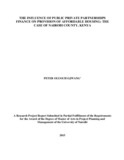| dc.description.abstract | The purpose of this study was to establish the influence of Public Private Partnerships (PPP)
Finance on Provision of Affordable Housing in Nairobi County, Kenya. The four objectives of this
study were to establish the influence of Risk Allocation, to determine the influence of Private Capital,
to examine the influence of Delivery Time and to establish the influence of Cost Savings, in PPP
Finance on the provision of affordable housing in Nairobi County. Descriptive survey research design
was adopted for this study, with the target population being the key public and private sector
stakeholders in provision of affordable housing in Nairobi County. In the public sector top management
and heads of departments in the Ministry of Land Housing and Urban Development directorate of
housing, PPP Unit domiciled in the Treasury, National Housing Corporation and Senior civil servants
in the Nairobi City County department of housing, the private sector on the other hand included;
Developers, contractors, financiers and professionals forming a total target population of 80. The study
considered a sample size of 66 determined using Krejcie & Morgan table, purposive and stratified
random sampling was used to draw samples from the population. The researcher collected primary data
using semi-structured questionnaire and interview guide, while secondary data was collected from
published books, peer reviewed journals reports and other academic articles. The questionnaire was
pretested and pilot tested to help in identifying deficiencies in the questionnaire which were then
refined for validity. Split-half method was used to test the reliability of the tools, while Cronbach’s
alpha was computed to measure internal consistency reliability for the multipoint-scaled items in the
questionnaire. The quantitative data collected was analyzed using descriptive statistics; frequencies and
percentages, through the Statistical Package for Social Sciences (SPSS), while inferential statistic
Spearman’s rank coefficient was used to measure the influence of independent variables on the
dependent variable. Content analysis was used for qualitative analysis of data gathered from interviews
and open ended questions in the research questionnaire. The study found out that the risk allocation,
private capital, delivery time and cost savings in a Public Private Partnerships model of procurement
have an influence in provision of affordable housing in Nairobi County, especially for the lower and
middle income groups, all the four in dependent variables recorded a positive correlation with the
dependent variable provision of affordable housing in Nairobi. In conclusion it is the finding of this
study that through a measure of government subsidy and cross subsidy affordability of the housing
units to the targeted low income households will be enhanced, secondly this would enhance the
commercial viability of the PPP affordable housing projects attractive to private partners. Appropriate
risk allocation among the partners creates cost savings in the whole life cycle approach where the
technology, efficiency and project management expertise of the private sector is harnessed for public
social infrastructure project for the low income households. | en_US |

